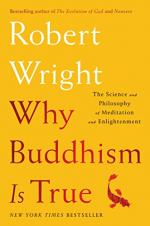
|
| Name: _________________________ | Period: ___________________ |
This test consists of 5 multiple choice questions, 5 short answer questions, and 10 short essay questions.
Multiple Choice Questions
1. What experiments are said to have "powerfully demonstrated the capacity of the conscious self to convince itself that it is calling the shots when it is not" (79)?
(a) Colostrum experiments.
(b) Split-brain experiments.
(c) Dual-self experiments.
(d) Corpus callosum experiments.
2. How did the author feel when his meditation teacher told him that his frustration with meditation was a good sign?
(a) Assured.
(b) Patronized.
(c) Ashamed.
(d) Proud.
3. What two drugs does the author say he imagines produce results similar to the feelings he had after a particularly good session of meditation at his first retreat?
(a) Cocaine and valium.
(b) LSD and psilocybin.
(c) LSD and heroin.
(d) Valium and heroin.
4. The author states that when the Buddhist techniques work, a person receives not just happiness, but what other element?
(a) Tranquility.
(b) Clarity of vision.
(c) Improved health.
(d) A youthful smile.
5. In most people, the left hemisphere of the brain controls what?
(a) Decision-making.
(b) Emotions.
(c) Language.
(d) Affection.
Short Answer Questions
1. What do psychologists call the condition of "being stuck" in the natural human cycle of ultimately futile pleasure-seeking?
2. How many parts belong to the Path that "deeply committed Buddhists are supposed to tread" (48)?
3. When ancient Buddhist writings mention the term sati, what does the word mean in English?
4. Which group of people does the author say especially identified with the film he references within the chapter title "Take the Red Pill"?
5. In what state did the author attend his very first silent meditation retreat?
Short Essay Questions
1. Discuss the tendency of humans to engage in self-inflation.
2. To whom does the author recommend a meditation practice?
3. What is the nature of the author's characterization of a meditation retreat?
4. How does the author use the example of the scar experiment?
5. How does the author use the discussion of pain to illustrate his points about not-self?
6. How does the author use the example of bodily fluids in order to demonstrate the differences between Western Buddhism and Traditional Buddhism?
7. What effect is the author's choice of the word "delusions" intended to have on the reader?
8. What does the author say about ways in which people should NOT "conceive of modules" (86)?
9. What is witness consciousness, according to the author?
10. For what purpose does the author begin the entire narrative with a question?
|
This section contains 1,490 words (approx. 5 pages at 300 words per page) |

|




